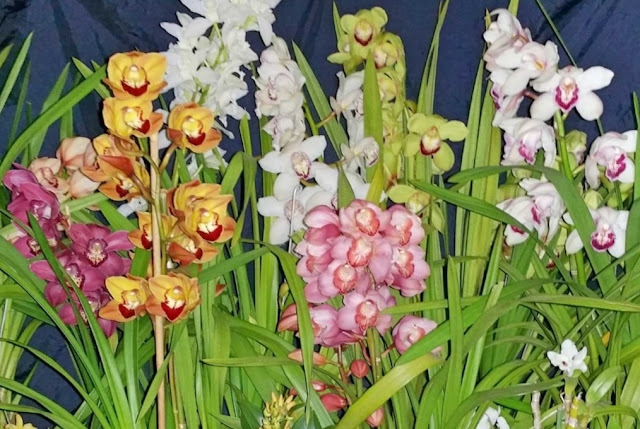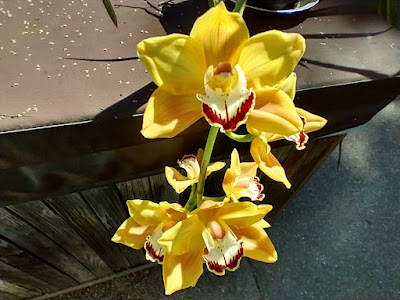
Orchid event spotlights semi-tropical favorite that thrives outdoors

|
|
Cymbidiums at their peak of bloom will be on display Saturday. (Photo courtesy of Sacramento Valley Cymbidium Society)
|
Among the many flowers that bloom in March in Sacramento are spectacular orchids – outdoors.
Cymbidiums, also known as boat orchids, bloom in massive clusters on three-foot-long spikes. With a little protection against frost, these orchids thrive in Sacramento’s mild climate. It’s exposure to temperatures below 55 degrees in winter that prompts all those flowers.
See scores of locally grown cymbidiums in full bloom on Saturday during a spectacular Sacramento show – and take some home, too.
The
Sacramento Valley Cymbidium Society
hosts its spring show and sale from 10 a.m. to 4 p.m. Saturday, March 26, at Shepard Garden and Arts Center in McKinley Park. Parking and admission are free.
Society members will be on hand to offer growing tips for these semi-tropical wonders. Cymbidiums appreciate Sacramento’s summer warmth – as long as they have a place in the afternoon shade and sufficient water.
“We look forward to welcoming you to see our plants, learn how to repot any pot-bound plants you may have or inherited, and buy repotting product,” the club posted on Facebook. “We will also be raffling off a plant as a door prize – free ticket!”
Judging by my own plants, our mild winter produced wonderful cymbidium growing conditions. In my garden, one large yellow cymbidium has 17 big blooms, divided between two tall spikes.
These flowers are long lasting, too; the blooms will stay on the plant for several weeks.
Learn more Saturday at this orchid show and sale. Shepard Center is located at 3330 McKinley Blvd., Sacramento.
Questions? Please email Lee Turner at turnermuecke@sbcgloval.net.
Details and directions:
www.sgaac.org
.
— Debbie Arrington

|
|
Some of the 17 big blooms on Debbie's cymbidium. (Photo: Debbie Arrington)
|
Comments
0 comments have been posted.Sacramento Digs Gardening to your inbox.
Food in My Back Yard Series
May 6: Maintain soil moisture with mulch for garden success
April 29: What's (already) wrong with my tomato plants?
April 22: Should you stock up on fertilizer? (Yes!)
April 15: Grow culinary herbs in containers
April 8: When to plant summer vegetables
April 1: Don't be fooled by these garden myths
March 25: Fertilizer tips: How to 'feed' your vegetables for healthy growth
March 18: Time to give vegetable seedlings some more space
March 11: Ways to win the fight against weeds
March 4: Potatoes from the garden
Feb. 25: Plant a fruit tree now -- for later
Feb. 18: How to squeeze more food into less space
Feb. 11: When to plant? Consider staggering your transplants
Feb. 4: Starting in seed starting
Sites We Like
Garden Checklist for week of May 11
Make the most of the lower temperatures early in the week. We’ll be back in the 80s by Thursday.
* Plant, plant, plant! It’s prime planting season in the Sacramento area. Time to set out those tomato transplants along with peppers and eggplants. Pinch off any flowers on new transplants to make them concentrate on establishing roots instead of setting premature fruit.
* Direct-seed melons, cucumbers, summer squash, corn, radishes, pumpkins and annual herbs such as basil.
* Harvest cabbage, lettuce, peas and green onions.
* In the flower garden, direct-seed sunflowers, cosmos, salvia, zinnias, marigolds, celosia and asters. (You also can transplant seedlings for many of the same flowers.)
* Plant dahlia tubers.
* Transplant petunias, marigolds and perennial flowers such as astilbe, columbine, coneflowers, coreopsis, dahlias, rudbeckia and verbena.
* Keep an eye out for slugs, snails, earwigs and aphids that want to dine on tender new growth.
* Feed summer bloomers with a balanced fertilizer.
* For continued bloom, cut off spent flowers on roses as well as other flowering plants.
* Add mulch to the garden to maintain moisture. Mulch also cuts down on weeds. But don’t let it mound around the stems or trunks of trees or shrubs. Leave about a 6-inch-to-1-foot circle to avoid crown rot or other problems.
* Remember to weed! Pull those nasties before they set seed.
* Water early in the day and keep seedlings evenly moist.